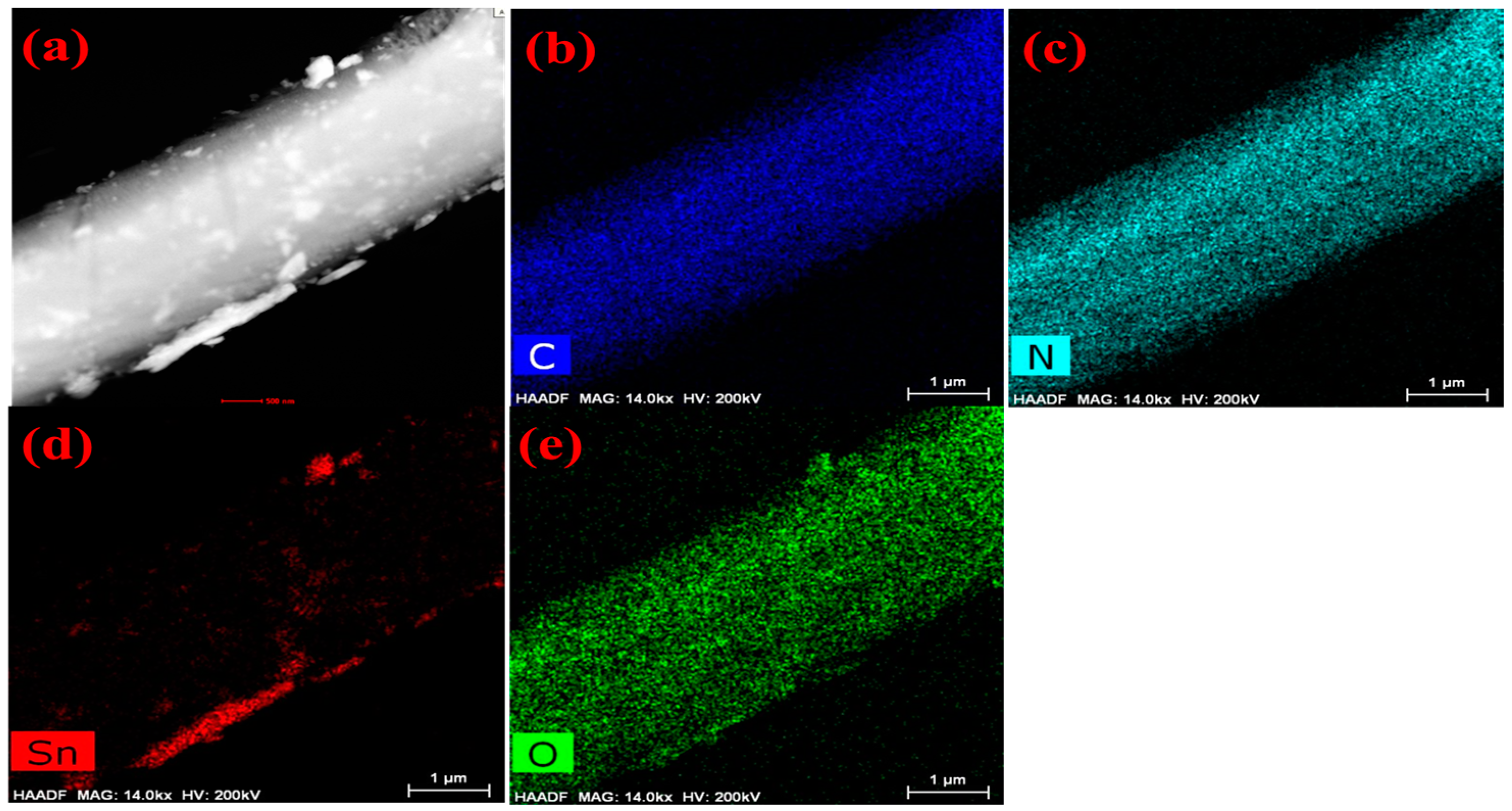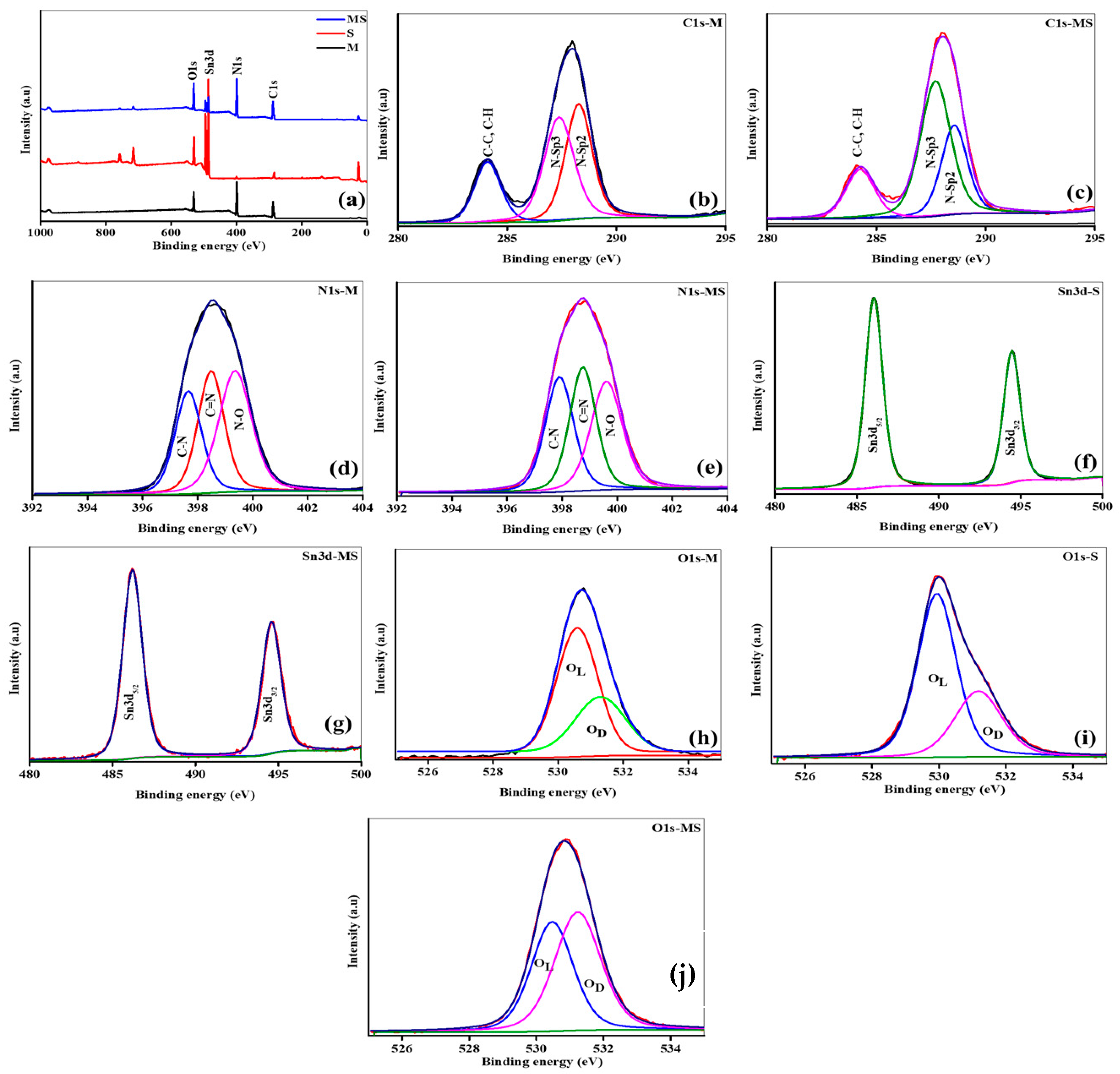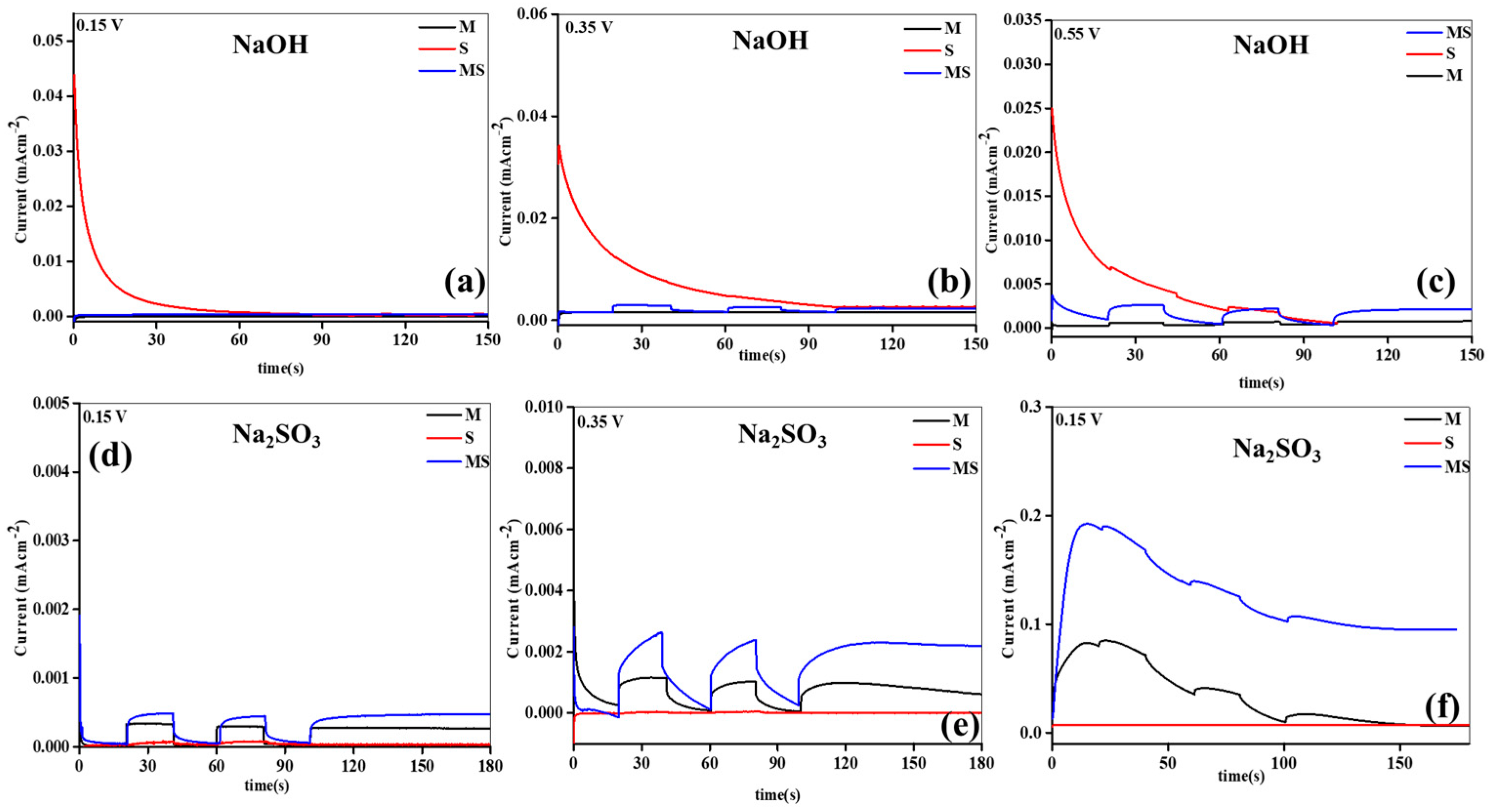Melamine Cyanaurate Microrods Decorated with SnO2 Quantum Dots for Photoelectrochemical Applications
Abstract
:1. Introduction
2. Experimental and Characterization
2.1. Synthesis of Melamine Cyanaurate Microrods
2.2. Synthesis of Tin(IV) Oxide Nanostructures
2.3. Synthesis of Melamine Cyanaurate Microrods Decorated with SnO2 Structures
2.4. Preparation of Electrodes
2.5. Characterization Techniques
2.6. Photoelectrochemical Studies
3. Results and Discussion
4. Conclusions
Supplementary Materials
Author Contributions
Funding
Data Availability Statement
Acknowledgments
Conflicts of Interest
References
- Hoffmann, M.R.; Martin, S.T.; Choi, W.; Bahnemann, D.W. Environmental Applications of Semiconductor Photocatalysis. Chem. Rev. 1995, 95, 69–96. [Google Scholar] [CrossRef]
- Sakthivel, S.; Neppolian, B.; Shankar, M.V.; Arabindoo, B.; Palanichamy, M.; Murugesan, V. Solar photocatalytic degradation of Azo dye: Comparison of photocatalytic efficiency of ZnO and TiO2. Sol. Energy Mater. Sol. Cells 2003, 77, 65–82. [Google Scholar] [CrossRef]
- Vinodgopal, K.; Kamat, P.V. Enhanced rates of photocatalytic degradation of an Azo dye using SnO2/TiO2 coupled semiconductor thin films. Environ. Sci. Technol. 1995, 29, 841–845. [Google Scholar] [CrossRef] [PubMed]
- Li, L.; Chu, Y.; Liu, Y.; Dong, L. Template-free synthesis and photocatalytic properties of novel, Fe2O3 hollow spheres. J. Phys. Chem. C 2007, 111, 2123–2127. [Google Scholar] [CrossRef]
- Chen, D.; Ye, J. Hierarchical WO3 hollow shells: Dendrite, sphere, dumbbell, and their photocatalytic properties. Adv. Funct. Mater. 2008, 18, 1922–1928. [Google Scholar] [CrossRef]
- Arifin, K.; Yunus, R.M.; Minggu, L.J.; Kassim, M.B. Improvement of TiO2 nanotubes for photoelectrochemical water splitting: Review. Int. J. Hydrogen Energy 2020, 46, 4998–5024. [Google Scholar] [CrossRef]
- Wang, Y.L.; Fan, L.Q.; Sun, S.J.; Chen, J.J.; Wu, Z.X.; Zhu, T.T.; Huang, Y.F.; Wu, J.H. Ti3C2Tx MXene supported SnO2 quantum dots with oxygen vacancies as anode for Li-ion capacitors. Chem. Eng. J. 2022, 428, 131993. [Google Scholar] [CrossRef]
- Das, J.; Dhar, S.S. Synthesis of SnO2 quantum dots mediated by Camellia sinensis shoots for degradation of thiamethoxam. Toxicol. Environ. Chem. 2020, 102, 186–196. [Google Scholar] [CrossRef]
- Zhou, J.T.; Lyu, M.; Zhu, J.; Li, G.N.; Li, Y.T.; Jin, S.Z.; Song, J.L.; Niu, H.H.; Xu, J.Z.; Zhou, R. SnO2 Quantum Dot-Modified Mesoporous TiO2 Electron Transport Layer for Efficient and Stable Perovskite Solar Cells. ACS Appl. Energy Mater. 2022, 5, 3052–3063. [Google Scholar] [CrossRef]
- Jin, W.; Wang, H.; Liu, Y.L.; Yang, S.; Zhou, J.; Chen, W. SnO2 Quantum Dots-Functionalized MoO3 Nanobelts for High-Selectivity Ethylene Sensing. ACS Appl. Nano Mater. 2022, 5, 10485–10494. [Google Scholar] [CrossRef]
- Wu, Z.D.; Jing, H.Y.; Zhao, Y.; Lu, K.R.; Liu, B.Y.; Yu, J.; Xia, X.F.; Lei, W.; Hao, Q.L. Grain boundary and interface interaction Co-regulation promotes SnO2 quantum dots for efficient CO2 reduction. Chem. Eng. J. 2023, 451, 138477. [Google Scholar] [CrossRef]
- Reddy, I.N.; Manjunath, V.; Shim, J. SnO2 QDs-decorated V2O5 nanobelts for photoelectrochemical water splitting under visible light. Ceram. Int. 2021, 47, 21127–21139. [Google Scholar] [CrossRef]
- Zou, Y.; Xie, Y.; Yu, S.; Chen, L.; Cui, W.; Dong, F.; Zhou, Y. SnO2 quantum dots anchored on g-C3N4 for enhanced visible-light photocatalytic removal of NO and toxic NO2 inhibition. Appl. Surf. Sci. 2019, 496, 143630. [Google Scholar] [CrossRef]
- Zhu, A.; Zhao, Q.; Li, X.; Shi, Y. BiFeO3/TiO2 nanotube arrays composite electrode: Construction, characterization, and enhanced photoelectrochemical properties. ACS Appl. Mater. Interfaces 2014, 6, 671–679. [Google Scholar] [CrossRef] [PubMed]
- Li, Y.; Zhang, D.; Fan, J.; Xiang, Q. Highly crystalline carbon nitride hollow spheres with enhanced photocatalytic performance. Chin. J. Catal. 2021, 42, 627–636. [Google Scholar] [CrossRef]
- Huang, M.; Yu, J.; Li, B.; Deng, C.; Wang, L.; Wu, W.; Dong, L.; Zhang, F.; Fan, M. Intergrowth and coexistence effects of TiO2-SnO2 nanocomposite with excellent photocatalytic activity. J. Alloys Compd. 2015, 629, 55–61. [Google Scholar] [CrossRef]
- Niu, M.; Huang, F.; Cui, L.; Huang, P.; Yu, Y.; Wang, Y. Hydrothermal synthesis, structural characteristics, and enhanced photocatalysis of SnO2/α-Fe2O3 semiconductor nanoheterostructures. ACS Nano 2010, 4, 681–688. [Google Scholar] [CrossRef]
- Wen, Z.; Wang, G.; Lu, W.; Wang, Q.; Zhang, Q.; Li, J. Enhanced photocatalytic properties of mesoporous SnO2 induced by low concentration ZnO doping. Cryst. Growth Des. 2007, 7, 1722–1725. [Google Scholar] [CrossRef]
- Zhang, Z.Y.; Shao, C.L.; Li, X.H.; Zhang, L.; Xue, H.M.; Wang, C.H.; Liu, Y.C. Electrospun nanofibers of ZnO-SnO2 heterojunction with high phtocatalytic activity. J. Phys. Chem. C 2010, 114, 7920–7925. [Google Scholar] [CrossRef]
- Jiang, F.; Li, R.; Cai, J.; Xu, W.; Cao, A.; Chen, D.; Zhang, X.; Wang, C.; Shu, C. Ultrasmall Pd/Au bimetallic nanocrystals embedded in hydrogen-bonded supramolecular structures: Facile synthesis and catalytic activities in the reduction of 4-nitrophenol. J. Mater. Chem. A 2015, 3, 19433–19438. [Google Scholar] [CrossRef]
- Biju, C.S.; Raja, D.H.; Padiyan, D.P. Fabrication of α-Fe2O3 hexagonal disc/SnO2 nanoparticle semiconductor nanoheterostructures and its properties. Chem. Phys. Lett. 2015, 619, 1–6. [Google Scholar] [CrossRef]
- Cheng, H.; Shapter, J.G.; Li, Y.; Gao, G. Recent progress of advanced anode materials of lithium-ion batteries. J. Energy Chem. 2021, 57, 451–468. [Google Scholar] [CrossRef]
- Herbstein, F.H. Purported “melamine cyanuric acid trihydrochloride” C3H6N6·C3H3N3O3·3HCl is actually “diprotonated-melamine cyanuric acid dichloride dihydrate” (C3H8N6)2+·C3H3N3O3·2Cl−·2H2O. J. Chem. Crystallogr. 2003, 33, 527–529. [Google Scholar] [CrossRef]
- Seifer, G.R. Cyanuric acid and cyanurates. Russ. J. Coord. Chem. 2002, 28, 301–324. [Google Scholar] [CrossRef]
- Jones, W.J.; Orville-Thomas, W.J. The infra-red spectrum and structure of dicyandiamide. Trans. Faraday Soc. 1959, 55, 193–202. [Google Scholar] [CrossRef]
- Larkin, P.J.; Makowski, M.P.; Colthup, N.B.; Flood, L.A. Vibrational analysis of some important group frequencies of melamine derivatives containing methoxymethyl, and carbamate substituents: Mechanical coupling of substituent vibrations with triazine ring modes. Vib. Spectrosc. 1998, 17, 53–72. [Google Scholar] [CrossRef]
- Debrus, S.; Marchewka, M.K.; Drozd, M.; Ratajczak, H. Vibrational, calorimetric and nonlinear optical studies of melaminium-bis(trichloroacetate) monohydrate molecularionic crystal. Opt. Mater. 2007, 29, 1058–1062. [Google Scholar] [CrossRef]
- García-López, E.; Marci, G.; Serpone, N.; Hidaka, H. Photoassisted oxidation of the recalcitrant cyanuric acid substrate in aqueous ZnO suspensions. J. Phys. Chem. C 2007, 111, 18025–18032. [Google Scholar] [CrossRef]
- Saatlu, A.M.; Procek, M.; Mattsson, C.; Thungstrom, G.; Torndahl, T.; Li, B.; Su, J.; Xiong, W.; Radamson, H.H. Nanometer-thick ZnO/SnO2 heterostructures grown on alumina for H2S sensing. ACS Appl. Nano Mater. 2022, 5, 6954–6963. [Google Scholar] [CrossRef]
- Zulfqar, S.; Iqbal, Z.; Lü, J. Zn–Cu-codoped SnO2 nanoparticles: Structural, optical, and ferromagnetic behaviors. Chin. Phys. B 2017, 26, 126104. [Google Scholar] [CrossRef]
- Bhattacharjee, A.; Ahmaruzzaman, M. A green and novel approach for the synthesis of SnO2 nanoparticles and its exploitation as a catalyst in the degradation of methylene blue under solar radiation. Mater. Lett. 2015, 145, 74. [Google Scholar] [CrossRef]
- Garg, D.; Shmila, T.; Mark, G.; Mondal, S.; Battula, V.R.; Volokh, M.L.; Shalom, M. The Design of Supramolecular Assemblies with Metal Saltas Precursors Enables the Growth of Stable PolymericCarbon Nitride Photoanodes. Adv. Sustain. Syst. 2023, 2300447. [Google Scholar] [CrossRef]
- Mao, Y.; Duan, H.; Xu, B.; Zhang, L.; Hu, Y.; Zhao, C.; Wang, Z.; Chen, L.; Yang, Y. Lithium storage in nitrogen-rich mesoporous carbon materials. Energy Environ. Sci. 2012, 5, 7950–7955. [Google Scholar] [CrossRef]
- El ouardi, M.; El Idrissi, A.; Arab, M.; Zbair, M.; Haspel, H.; Saadi, M.; Ahsaine, H.A. Review of photoelectrochemical water splitting: From quantitative approaches to effect of sacrificial agents, oxygen vacancies, thermal and magnetic field on (photo)electrolysis. Int. J. Hydrogen Energy 2024, 51, 1044–1067. [Google Scholar] [CrossRef]
- Lopes, T.; Andrade, L.; Ribeiro, H.A.; Mendes, A. Characterization of photoelectrochemical cells for water splitting by electrochemical impedance spectroscopy. Int. J. Hydrogen Energy 2010, 35, 11601–11608. [Google Scholar] [CrossRef]
- Reddy, I.N.; Sreedhar, A.; Reddy, C.V.; Shim, J.; Cho, M.; Yoo, K.; Kim, D.; Gwag, J.S. High performance hierarchical SiCN nanowires for efficient photocatalytic -photoelectrocatalytic and supercapacitor applications. Appl. Catal. B Environ. 2018, 237, 876–887. [Google Scholar] [CrossRef]
- Liao, L.; Zhu, J.; Bian, X.; Zhu, L.; Scanlon, M.D.; Girault, H.H.; Liu, B. MoS2 Formed on Mesoporous Graphene as a Highly Active Catalyst for Hydrogen Evolution. Adv. Funct. Mater. 2013, 23, 5326–5333. [Google Scholar] [CrossRef]
- Suen, N.; Hung, S.; Quan, Q.; Zhang, N.; Xu, Y.; Chen, H.M. Electrocatalysis for the oxygen evolution reaction: Recent development and future perspectives. Chem. Soc. Rev. 2017, 46, 337–365. [Google Scholar] [CrossRef] [PubMed]





| Anode | Electrolyte 0.1 M | State | R1 (Ω) | R2 (Ω) | R3 (Ω) | C1 (nF) | C3 (mF) |
|---|---|---|---|---|---|---|---|
| Melamine cyanaurate (M) | NaOH | Dark | 13.33 | 55.05 | 6922.09 | 252.90 | 9.46 |
| Light | 13.29 | 55.04 | 5828.12 | 258.84 | 9.51 | ||
| SnO2 (S) | Dark | 13.74 | 49.88 | 1963.74 | 153.30 | 7.42 | |
| Light | 13.13 | 49.75 | 1046.42 | 160.20 | 7.72 | ||
| Melamine cyanaurate–SnO2 (MS) | Dark | 11.09 | 38.21 | 2074.60 | 123.10 | 13.36 | |
| Light | 11.08 | 38.19 | 1928.29 | 132.81 | 13.55 | ||
| Melamine cyanaurate (M) | Na2SO3 | Dark | 5.87 | 36.95 | 1230.03 | 3.31 | 13.39 |
| Light | 5.13 | 36.85 | 1197.83 | 3.35 | 13.48 | ||
| SnO2 (S) | Dark | 7.01 | 39.02 | 1725.77 | 2.50 | 10.23 | |
| Light | 6.91 | 38.98 | 1732.28 | 2.53 | 10.24 | ||
| Melamine cyanaurate–SnO2 (MS) | Dark | 1.57 | 30.73 | 975.88 | 2.31 | 14.30 | |
| Light | 1.36 | 30.28 | 929.71 | 2.48 | 14.36 |
| Electrolyte 0.1 M | Photoelectrode | Tafel Slopes | Jid | Jed | |||
|---|---|---|---|---|---|---|---|
| Dark mVdec−1 | Light mVdec−1 | Dark mAcm−2 | Light mAcm−2 | Dark mAcm−2 | Light mAcm−2 | ||
| NaOH | Melamine cyanaurate (M) | 88.9 | 76.1 | −1.95 | −1.94 | −5.11 | −4.86 |
| SnO2 (S) | 89.8 | 86.3 | −1.39 | −1.30 | −3.43 | −3.36 | |
| Melamine cyanaurate–SnO2 (MS) | 64.6 | 58.6 | −1.98 | −1.97 | −4.88 | −4.81 | |
| Na2SO3 | Melamine cyanaurate (M) | 63.8 | 59.3 | −3.03 | −2.04 | −4.64 | −4.80 |
| SnO2 (S) | 75.3 | 63.6 | −2.37 | −2.23 | −5.17 | −5.07 | |
| Melamine cyanaurate–SnO2 (MS) | 55.4 | 47.8 | −1.88 | −1.79 | −4.17 | −3.30 | |
Disclaimer/Publisher’s Note: The statements, opinions and data contained in all publications are solely those of the individual author(s) and contributor(s) and not of MDPI and/or the editor(s). MDPI and/or the editor(s) disclaim responsibility for any injury to people or property resulting from any ideas, methods, instructions or products referred to in the content. |
© 2024 by the authors. Licensee MDPI, Basel, Switzerland. This article is an open access article distributed under the terms and conditions of the Creative Commons Attribution (CC BY) license (https://creativecommons.org/licenses/by/4.0/).
Share and Cite
Reddy, I.N.; Akkinepally, B.; Dhanasekar, M.; Shim, J.; Bai, C. Melamine Cyanaurate Microrods Decorated with SnO2 Quantum Dots for Photoelectrochemical Applications. Crystals 2024, 14, 302. https://doi.org/10.3390/cryst14040302
Reddy IN, Akkinepally B, Dhanasekar M, Shim J, Bai C. Melamine Cyanaurate Microrods Decorated with SnO2 Quantum Dots for Photoelectrochemical Applications. Crystals. 2024; 14(4):302. https://doi.org/10.3390/cryst14040302
Chicago/Turabian StyleReddy, Itheereddi Neelakanta, Bhargav Akkinepally, Moorthy Dhanasekar, Jaesool Shim, and Cheolho Bai. 2024. "Melamine Cyanaurate Microrods Decorated with SnO2 Quantum Dots for Photoelectrochemical Applications" Crystals 14, no. 4: 302. https://doi.org/10.3390/cryst14040302







